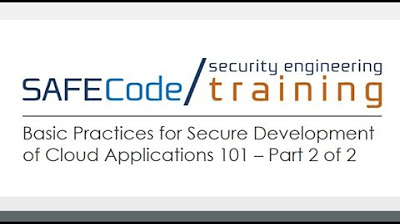How to implement ISO 27001 Annex A 5.1 Policies for Information Security
Summary
TLDRThis video script provides a comprehensive guide to implementing information security policies in line with ISO 27001 Annex A 5.1. It emphasizes the distinction between policies and processes, advocating for clear communication of policies to staff and stakeholders without compromising confidentiality. The script introduces the updated 2022 standard's approach to information security, suggesting a high-level policy supported by topic-specific policies. It outlines steps for policy creation, ownership, approval, distribution, and annual review, highlighting the importance of documentation and employee acknowledgment. The narrator, Stuart Barker, offers practical advice for policy management and preparation for ISO 27001 certification.
Takeaways
- 📜 ISO 27001 Annex A 5.1 focuses on establishing information security policies.
- 💼 Policies should state what the organization does, not how it does it.
- 🔗 Policies are separated from processes to protect sensitive information and avoid confusion.
- 📈 The updated 2022 version of ISO 27001 emphasizes a high-level information security policy and topic-specific policies.
- 🛠️ The ISO 27001 toolkit is a valuable resource for creating and implementing policies.
- 📝 Policies should be based on identified risks and the controls chosen to mitigate them.
- 👤 Policies should have clear ownership and accountability within the organization.
- ✅ Policies must be approved through an internal approval process.
- 📢 Policies need to be distributed and acknowledged by relevant personnel.
- 🔄 Regular updates and reviews of policies are necessary, at least annually.
- 📈 Auditors look for evidence of policy approval, distribution, and acceptance.
Q & A
What is the main focus of ISO 27001 Annex A 5.1?
-The main focus of ISO 27001 Annex A 5.1 is on information security policies, which are statements of what an organization does for certain topics related to information security.
Why is it important to separate policies from process documentation?
-Policies should be separated from process documentation to avoid exposing sensitive internal operations and to prevent confusion. Policies communicate what is done, while processes explain how it is done.
What is the difference between a high-level information security policy and topic-specific policies?
-A high-level information security policy provides an overarching statement of the organization's commitment to information security, while topic-specific policies address particular areas or requirements of ISO 27001.
Where can one find resources to help with implementing information security policies for ISO 27001?
-Resources for implementing information security policies can be found on hightable.io, which includes a video guide, a step-by-step guide, and a blog for more detailed information.
What is the recommended approach to creating information security policies according to the script?
-The recommended approach is to start with downloading the ISO 27001 toolkit, which contains pre-populated policies that can be rebranded and used as a starting point.
Who should own the information security policies within an organization?
-Policies should be owned by someone within the organization who is responsible for them, ensuring accountability.
How often should information security policies be reviewed and updated?
-Information security policies should be reviewed at least annually, and updated whenever there are changes to reflect those changes.
What is the importance of distributing and acknowledging policies within an organization?
-Distributing policies ensures that relevant staff are aware of them, and obtaining acknowledgements verifies that they have been read, understood, and accepted.
What does the ISO 27001 standard say about the necessity of policies for every control?
-The ISO 27001 standard does not require a policy for every single control. Policies should add value and be relevant to the organization's processes and risk management.
What are some top tips for maintaining and communicating information security policies?
-Top tips include regularly communicating the location of policies, reinforcing the message throughout the year, integrating policy communication into the HR onboarding process, and ensuring document markup and version control are consistent.
Who is Stuart Barker and what is his role in relation to ISO 27001?
-Stuart Barker is referred to as the ISO 27001 Ninja, and he provides guidance and resources for implementing ISO 27001 standards, including information security policies.
Outlines

Этот раздел доступен только подписчикам платных тарифов. Пожалуйста, перейдите на платный тариф для доступа.
Перейти на платный тарифMindmap

Этот раздел доступен только подписчикам платных тарифов. Пожалуйста, перейдите на платный тариф для доступа.
Перейти на платный тарифKeywords

Этот раздел доступен только подписчикам платных тарифов. Пожалуйста, перейдите на платный тариф для доступа.
Перейти на платный тарифHighlights

Этот раздел доступен только подписчикам платных тарифов. Пожалуйста, перейдите на платный тариф для доступа.
Перейти на платный тарифTranscripts

Этот раздел доступен только подписчикам платных тарифов. Пожалуйста, перейдите на платный тариф для доступа.
Перейти на платный тарифПосмотреть больше похожих видео

ISO 27001 - ENTENDA DE VEZ!

SAFECode Basic Practices for Secure Development of Cloud Applications 101 Quiz Part 2 p1

How to Write Information Security Policy

[BO] Khóa đào tạo An ninh thông tin ISMS

How to implement ISO 27001 Walkthrough - Part 1

Information Technology (IT) Risk and Management of IT Risks (Information Technology Risk Management)
5.0 / 5 (0 votes)
